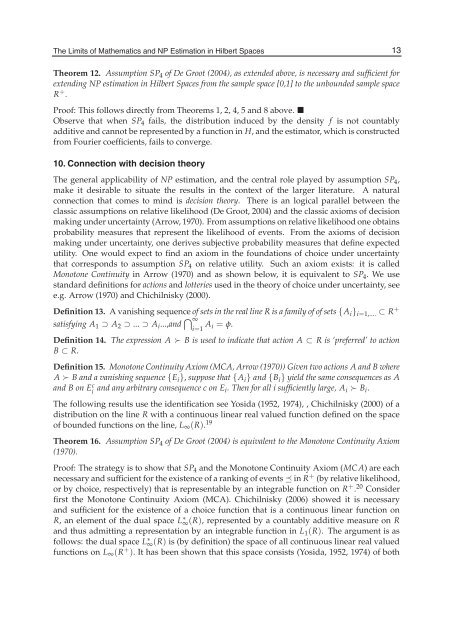The Limits of Mathematics and NP Estimation in ... - Chichilnisky
The Limits of Mathematics and NP Estimation in ... - Chichilnisky
The Limits of Mathematics and NP Estimation in ... - Chichilnisky
- No tags were found...
Create successful ePaper yourself
Turn your PDF publications into a flip-book with our unique Google optimized e-Paper software.
<strong>The</strong> <strong>Limits</strong> <strong>of</strong> <strong>Mathematics</strong><strong>and</strong> <strong>NP</strong> <strong>Estimation</strong> <strong>in</strong> Hilbert Spaces 11<strong>The</strong> <strong>Limits</strong> <strong>of</strong> <strong>Mathematics</strong> <strong>and</strong> <strong>NP</strong> <strong>Estimation</strong> <strong>in</strong> Hilbert Spaces13<strong>The</strong>orem 12. Assumption SP 4 <strong>of</strong> De Groot (2004), as extended above, is necessary <strong>and</strong> sufficient forextend<strong>in</strong>g <strong>NP</strong> estimation <strong>in</strong> Hilbert Spaces from the sample space [0,1] to the unbounded sample spaceR + .Pro<strong>of</strong>: This follows directly from <strong>The</strong>orems 1, 2, 4, 5 <strong>and</strong> 8 above. Observe that when SP 4 fails, the distribution <strong>in</strong>duced by the density f is not countablyadditive <strong>and</strong> cannot be represented by a function <strong>in</strong> H, <strong>and</strong> the estimator, which is constructedfrom Fourier coefficients, fails to converge.10. Connection with decision theory<strong>The</strong> general applicability <strong>of</strong> <strong>NP</strong> estimation, <strong>and</strong> the central role played by assumption SP 4 ,make it desirable to situate the results <strong>in</strong> the context <strong>of</strong> the larger literature. A naturalconnection that comes to m<strong>in</strong>d is decision theory. <strong>The</strong>re is an logical parallel between theclassic assumptions on relative likelihood (De Groot, 2004) <strong>and</strong> the classic axioms <strong>of</strong> decisionmak<strong>in</strong>g under uncerta<strong>in</strong>ty (Arrow, 1970). From assumptions on relative likelihood one obta<strong>in</strong>sprobability measures that represent the likelihood <strong>of</strong> events. From the axioms <strong>of</strong> decisionmak<strong>in</strong>g under uncerta<strong>in</strong>ty, one derives subjective probability measures that def<strong>in</strong>e expectedutility. One would expect to f<strong>in</strong>d an axiom <strong>in</strong> the foundations <strong>of</strong> choice under uncerta<strong>in</strong>tythat corresponds to assumption SP 4 on relative utility. Such an axiom exists: it is calledMonotone Cont<strong>in</strong>uity <strong>in</strong> Arrow (1970) <strong>and</strong> as shown below, it is equivalent to SP 4 .Weusest<strong>and</strong>ard def<strong>in</strong>itions for actions <strong>and</strong> lotteries used <strong>in</strong> the theory <strong>of</strong> choice under uncerta<strong>in</strong>ty, seee.g. Arrow (1970) <strong>and</strong> <strong>Chichilnisky</strong> (2000).Def<strong>in</strong>ition 13. A vanish<strong>in</strong>g sequence <strong>of</strong> sets <strong>in</strong> the real l<strong>in</strong>e R is a family <strong>of</strong> <strong>of</strong> sets {A i } i=1,.... ⊂ R +satisfy<strong>in</strong>g A 1 ⊃ A 2 ⊃ ... ⊃ A i ...,<strong>and</strong> ⋂ ∞i=1 A i = φ.Def<strong>in</strong>ition 14. <strong>The</strong> expression A ≻ B is used to <strong>in</strong>dicate that action A ⊂ R is ‘preferred’ to actionB ⊂ R.Def<strong>in</strong>ition 15. Monotone Cont<strong>in</strong>uity Axiom (MCA, Arrow (1970)) Given two actions A <strong>and</strong> B whereA ≻ B <strong>and</strong> a vanish<strong>in</strong>g sequence {E i }, suppose that {A i } <strong>and</strong> {B i } yield the same consequences as A<strong>and</strong> B on E c i <strong>and</strong> any arbitrary consequence c on E i . <strong>The</strong>n for all i sufficiently large, A i ≻ B i .<strong>The</strong> follow<strong>in</strong>g results use the identification see Yosida (1952, 1974), , <strong>Chichilnisky</strong> (2000) <strong>of</strong> adistribution on the l<strong>in</strong>e R with a cont<strong>in</strong>uous l<strong>in</strong>ear real valued function def<strong>in</strong>ed on the space<strong>of</strong> bounded functions on the l<strong>in</strong>e, L ∞ (R). 19<strong>The</strong>orem 16. Assumption SP 4 <strong>of</strong> De Groot (2004) is equivalent to the Monotone Cont<strong>in</strong>uity Axiom(1970).Pro<strong>of</strong>: <strong>The</strong> strategy is to show that SP 4 <strong>and</strong> the Monotone Cont<strong>in</strong>uity Axiom (MCA)areeachnecessary <strong>and</strong> sufficient for the existence <strong>of</strong> a rank<strong>in</strong>g <strong>of</strong> events ≼ <strong>in</strong> R + (by relative likelihood,or by choice, respectively) that is representable by an <strong>in</strong>tegrable function on R + . 20 Considerfirst the Monotone Cont<strong>in</strong>uity Axiom (MCA). <strong>Chichilnisky</strong> (2006) showed it is necessary<strong>and</strong> sufficient for the existence <strong>of</strong> a choice function that is a cont<strong>in</strong>uous l<strong>in</strong>ear function onR, anelement<strong>of</strong>thedualspaceL ∗ ∞(R), represented by a countably additive measure on R<strong>and</strong> thus admitt<strong>in</strong>g a representation by an <strong>in</strong>tegrable function <strong>in</strong> L 1 (R). <strong>The</strong> argument is asfollows: the dual space L ∗ ∞(R) is (by def<strong>in</strong>ition) the space <strong>of</strong> all cont<strong>in</strong>uous l<strong>in</strong>ear real valuedfunctions on L ∞ (R + ). It has been shown that this space consists (Yosida, 1952, 1974) <strong>of</strong> both








